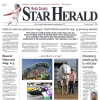By Sara StrongSo, you want to start a business by the new hospital, but it’s zoned residential. Or you want to convert your home on Highway 75 to a dental practice.Those kinds of issues will be addressed in the new Comprehensive Plan, which is still in the draft stages.The city of Luverne has been working on that, trying to form a guide that will influence decisions for the next 10 to 15 years.Although it doesn’t sound all that exciting to most, City Councilman David Hauge has been a longstanding advocate of a strong Comprehensive Plan.Hauge said, "We wish more people would have shown up, of course. There’s a lot of talented, intelligent people in the city that could’ve helped out."The public meetings didn’t draw as many people as the local Comprehensive Plan Task Force and the paid consultants had hoped. However, they say they got good information from participants. It seemed, at first, that participants wanted to talk about Fledgling Field, and both sides of the development issue showed up for that.The guided group activities made all participants answer specific questions on development issues in all parts of town. The end result of the information-gathering phase brought together a well-rounded collection of opinions.Creating a Comprehensive Plan without follow-through from Luverne’s leaders would mean all those efforts (and $50,000) were wasted."The important thing is, that as we leave office in the Council or Planning Commission, we educate people on the Comprehensive Plan," Hauge said.Past city leaders didn’t crack the booklet, and looked away from what was planned for development and zoning. Now, Planning Commission and City Council members are behind the plan.One aspect of the plan that became important was separating the existing land uses from the future plans for land uses. By defining future uses, the Comprehensive Task Force set a Land Use Plan.It provides the framework for the growth and development of Luverne. It also illustrates information gotten from community input and evaluations.Along with that, the Comprehensive Plan Task Force and hired consultants took a snapshot of Luverne in 2003, identifying the current use of each parcel of land.They divided land into a series of residential, commercial, industrial and public use types. The survey found that most land in Luverne is public/semi-public and low density residential — each making up 20 percent of land uses.Other uses were: river, 17 percent; vacant, 5 percent; agricultural, 18 percent; commercial, 6 percent; high density residential, 1 percent; industrial, 7 percent; medium density residential, 1 percent, and parks, 5 percent.The inventory of Luverne’s properties noted what the land is actually used for, not what it’s zone designation is.Low density residential is the typical single-family housing. Medium density residential refers to housing with two to four families in each building, including duplexes, triplexes, quadraplexes and attached town homes. It also includes single family homes that have been split into two to four units and manufactured home parks.High density residential is all forms of attached housing units with five or more units in a building. Commercial is all forms of retail and service businesses.Industrial includes all forms of businesses that manufacture or process food, goods, or equipment. It also includes warehouses and self-storage buildings. These typically don’t have space devoted to displays and don’t sell directly to the public.Public/semi-public refers to land owned by municipalities, counties or school districts. It also refers to land owned by institutions such as churches, hospitals and nursing homes.Parks are municipal and county-owned facilities such as playgrounds, ballfields and recreational trails.Agricultural land represents parcels currently being farmed or directly connected to a farming operation.Luverne contains approximately 2,200 acres of land.



